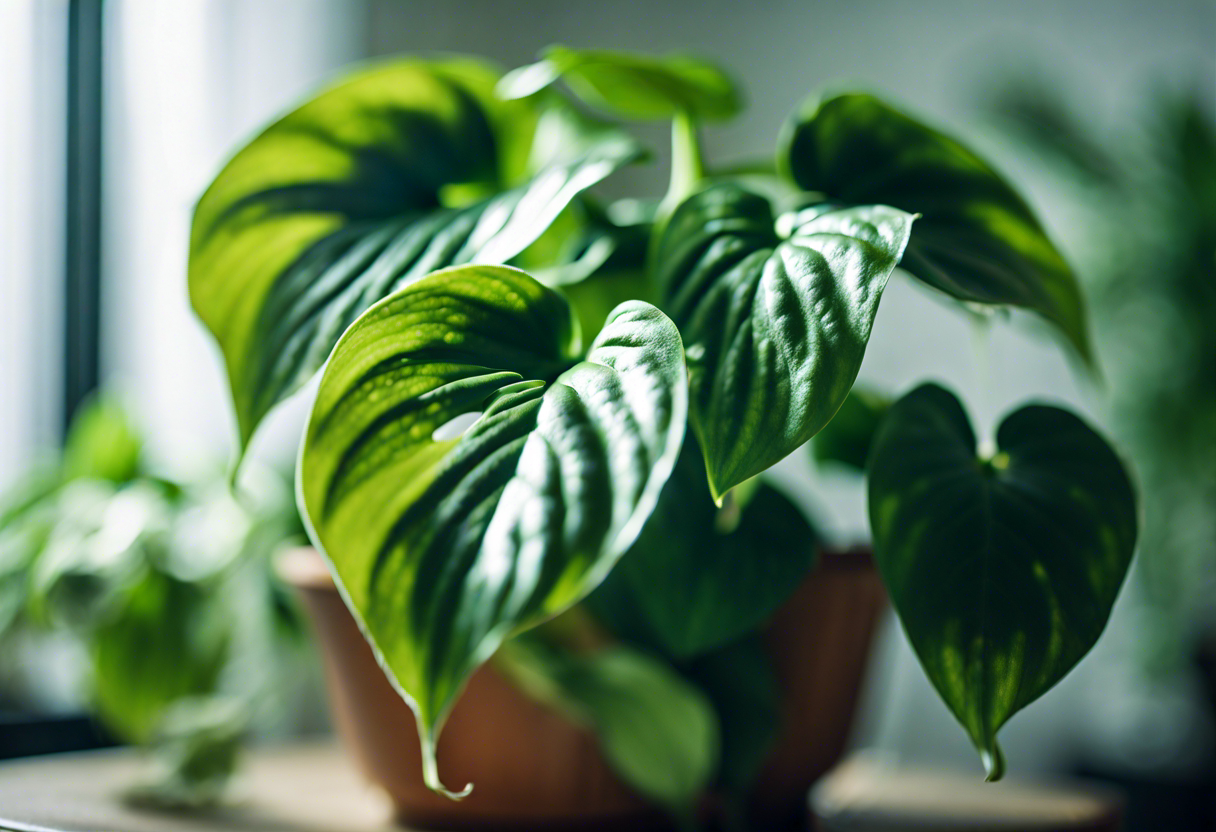Understanding the Basics of Pothos (Epipremnum aureum) Care
When it comes to indoor plants, Pothos (Epipremnum aureum) is a popular choice among plant enthusiasts. Known for its trailing vines and vibrant green leaves, Pothos is not only visually appealing but also relatively easy to care for. Whether you are a novice or an experienced plant parent, understanding the basics of Pothos care is essential to ensure its health and longevity.
One of the first things to consider when caring for Pothos is the potting mix and container. Pothos plants thrive in well-draining soil, so it’s important to choose a potting mix that provides good airflow and prevents waterlogged roots. A mix consisting of peat moss, perlite, and vermiculite or a commercial potting mix designed for houseplants can be suitable options. Additionally, selecting a container with drainage holes will help prevent water from stagnating at the bottom, reducing the risk of root rot.
Lighting plays a crucial role in the growth of Pothos plants. While they can tolerate low light conditions, they truly thrive in bright, indirect light. Placing your Pothos near a window with filtered sunlight is ideal. However, avoid exposing it to direct sunlight as this can scorch the leaves. If low light conditions are the only option, Pothos can still survive, but its growth may be slower, and the leaves might become less variegated.
Proper watering techniques are vital for Pothos care. As a general rule, allow the top inch of the soil to dry out before watering thoroughly. Overwatering can lead to root rot, while underwatering can cause the leaves to wilt and turn yellow. It’s essential to strike a balance and avoid extremes. During the cooler months, Pothos plants may require less frequent watering due to reduced evaporation rates.
Pruning and propagation are essential aspects of Pothos care. Pruning helps maintain the desired shape, promotes bushier growth, and prevents legginess. Trim yellowing or browning leaves and cut back long vines to maintain a fuller appearance. Propagating Pothos is relatively easy and can be done using stem cuttings. Simply cut a healthy vine below a node and place it in water or directly into moist soil. Over time, new roots will develop, and a new plant will begin to grow.
Understanding the basics of Pothos care allows you to create an optimal environment for this beautiful trailing plant. Consider the potting mix and container, provide adequate lighting, practice proper watering techniques, and carry out regular pruning and propagation. By following these guidelines, you can enjoy a thriving Pothos (Epipremnum aureum) in your indoor space.
Choosing the Right Potting Mix and Container for Your Pothos Plant
When it comes to the care of your Pothos (Epipremnum aureum) plant, choosing the right potting mix and container is essential for its growth and overall health. The right combination of potting mix and container will provide the necessary nutrients, drainage, and support for your Pothos to thrive.
Potting Mix:
The ideal potting mix for Pothos plants should be well-draining, which means it should allow excess water to escape easily. A potting mix that is too dense and retains water can lead to root rot and other moisture-related issues. To create a suitable potting mix for your Pothos, a combination of peat moss, perlite, and coarse sand is recommended. This mixture provides adequate aeration, drainage, and moisture retention for healthy root development.
Container:
When selecting a container for your Pothos plant, choose one that has drainage holes at the bottom. This will help prevent water from accumulating and causing issues such as root rot. Additionally, ensure that the container is of the appropriate size for your Pothos. A container that is too small can restrict root growth, while one that is too large may retain excess moisture. It’s best to choose a container that allows for some growth but still provides a snug fit for the plant.
Repotting:
Pothos plants generally require repotting every 1-2 years, or when they outgrow their current container. Signs that your Pothos may need repotting include roots growing out of the drainage holes, stunted growth, or a lack of visible growth despite adequate care. When repotting, gently remove the plant from its current container, loosening the roots if they are tightly bound. Place the plant in a larger container with fresh potting mix, ensuring that the root ball is centered and the plant is at the same depth as before. Water the plant thoroughly after repotting to help settle the new soil around the roots.
Maintenance:
To maintain the health of your Pothos plant, it’s important to monitor the moisture level of the potting mix. Stick your finger about an inch into the soil – if it feels dry, it’s time to water your plant. However, if the soil feels moist, hold off on watering to avoid overwatering. Remember that Pothos plants prefer slightly drier conditions rather than constantly wet soil.
Choosing the right potting mix and container is crucial for the successful care of your Pothos plant. By providing a well-draining potting mix and a properly sized container with good drainage, you can ensure that your Pothos thrives and continues to brighten up your home or office space with its lush foliage.
Understanding the Basics of Pothos (Epipremnum aureum) Care
Pothos (Epipremnum aureum), also known as Devil’s Ivy, is a popular houseplant known for its trailing vines and attractive heart-shaped leaves. It is an ideal choice for both beginner and experienced plant enthusiasts due to its easy care requirements and versatility. In this guide, we will explore the key aspects of caring for Pothos plants, including lighting requirements, watering techniques, and essential tips for pruning and propagation.
When it comes to lighting, Pothos plants are incredibly adaptable and can thrive in various light conditions. However, they prefer indirect, bright to moderate light, making them excellent choices for offices or areas without direct sunlight. Placing your Pothos near a window with sheer curtains can offer the perfect balance of light. Keep in mind that while Pothos plants can tolerate low light conditions, they may exhibit slower growth and variegated varieties may lose their vibrant colors.
Proper watering is crucial for the overall health of your Pothos plant. These plants prefer to be kept slightly on the drier side rather than too wet. Before watering, ensure the top inch of the soil feels dry to the touch. When watering, ensure that excess water drains out of the pot to prevent the roots from becoming waterlogged. Overwatering can lead to root rot, so it’s essential to strike a balance. It’s always better to underwater than overwater your Pothos.
Pruning is an essential part of Pothos care, as it helps maintain the desired shape, promote bushier growth, and prevent legginess. Pruning should be done in the spring or early summer when the plant is actively growing. You can trim back the vines just above a leaf node, which will encourage branching. Pruned cuttings can also be used for propagation, allowing you to expand your Pothos collection or share plants with friends.
Propagation is a rewarding and cost-effective way to expand your Pothos collection. One of the simplest propagation methods is through stem cuttings. Cut a healthy vine just below a node and place it in a jar of water or well-draining potting mix. Within a few weeks, you should see roots starting to develop. Once the roots have grown, you can transfer the cutting to a pot filled with potting soil. Remember to keep the soil slightly moist until the plant becomes established.
Understanding the basics of Pothos (Epipremnum aureum) care is essential for promoting healthy growth and longevity of these wonderful houseplants. By providing the right lighting conditions, practicing proper watering techniques, incorporating regular pruning, and exploring propagation methods, you can enjoy lush, trailing vines and vibrant foliage. With a little care and attention, your Pothos plant will thrive and bring beauty to any indoor space.
Proper Watering Techniques and Frequency for Pothos Plants
When it comes to caring for your Pothos (Epipremnum aureum) plant, proper watering techniques and frequency are crucial for ensuring its health and longevity. These lush, trailing plants are known for their tolerance to different conditions, making them a popular choice among both beginner and experienced gardeners. To help your Pothos thrive, it’s essential to understand the watering needs of this species and how to water it effectively.
One of the most important things to keep in mind when watering your Pothos plant is to avoid overwatering. Pothos plants are susceptible to root rot, which can occur if the roots are consistently sitting in waterlogged soil. To prevent this, it’s crucial to provide adequate drainage. Make sure that the pot you use has drainage holes to allow excess water to escape. Additionally, consider using a well-draining potting mix that allows water to flow through easily.
To determine when your Pothos plant needs watering, it’s best to assess the moisture level of the soil. Stick your finger about an inch into the soil and check if it feels dry. If the top inch of soil feels dry to the touch, it’s time to water your plant. However, if the soil still retains some moisture, it’s best to hold off on watering until it dries out a bit more.
When watering your Pothos, it’s important to give it a thorough soak. Water the plant until you see water coming out of the drainage holes. This ensures that the water reaches the deeper roots, promoting healthy growth. Avoid spraying water on the leaves, as this can lead to fungal diseases. Instead, focus on watering directly into the soil.
The frequency of watering your Pothos plant will depend on various factors such as the temperature, humidity, and the size of the pot. In general, Pothos plants prefer moderately moist soil. During the warmer months, you may need to water more frequently compared to the colder months.
During the growing season, which typically occurs in spring and summer, you can water your Pothos every 7-10 days. However, it’s crucial to monitor the moisture levels of the soil rather than following a strict schedule. Adjust the frequency based on your plant’s needs.
In contrast, during the winter months when the plant is in its dormant phase, you can reduce the watering frequency to once every two to three weeks. Remember, it’s better to underwater your Pothos rather than overwater it. Over time, you’ll develop a better understanding of your plant’s specific watering needs and can adjust accordingly.
By following proper watering techniques and monitoring the moisture levels of the soil, you can ensure that your Pothos (Epipremnum aureum) plant thrives and continues to bring beauty and vibrancy to your home or office space. Remember, consistency is key, and with time, you’ll become a pro at providing your Pothos with the perfect amount of water it needs to flourish.
Pruning and Propagation Tips for Pothos (Epipremnum aureum)
When it comes to caring for your Pothos (Epipremnum aureum) plant, pruning and propagation are important techniques to maintain its health and promote growth. Pruning helps to shape the plant and keep it looking neat, while propagation allows you to create new Pothos plants from cuttings. In this guide, we will explore the best practices for pruning and propagation to ensure the continued vitality of your Pothos plant.
Pruning Pothos Plants:
Regular pruning is key to keeping your Pothos plant thriving. Pruning not only helps to control the size and shape of the plant but also stimulates new growth. Here are some tips on how to prune your Pothos effectively:
-
Remove dead or yellowing leaves: Start by identifying any dead or yellowing leaves on your Pothos plant. These leaves are no longer providing nutrients to the plant and can be safely removed. Use clean, sharp scissors or pruning shears to make a clean cut close to the main stem.
-
Trim overgrown stems: If your Pothos plant has stems that are getting too long or leggy, you can trim them back to encourage bushier growth. Look for a node, which is a small bump on the stem, and make a diagonal cut just above it. New growth will develop from the node, creating a fuller and more compact plant.
-
Control the size: Pothos plants can grow quite large if left unpruned. If you prefer a more compact plant, you can trim the stems back to your desired length. Keep in mind that Pothos plants tolerate pruning well, so don’t be afraid to remove a substantial amount of growth if needed.
Propagation Techniques:
Propagating Pothos plants is a straightforward process that allows you to expand your collection or share plants with friends and family. Here are two common methods of propagation:
-
Water propagation: Water propagation is a simple and effective way to propagate Pothos plants. Take a healthy stem cutting, about 4-6 inches long, just below a node. Remove any leaves from the lower part of the cutting and place it in a glass or jar filled with water. Ensure that a few nodes are submerged in the water. Place the container in a bright, indirect light location and change the water every few days. After a few weeks, you will notice roots forming. Once the roots are a couple of inches long, you can transfer the cutting to a pot with soil.
-
Soil propagation: Soil propagation involves planting the stem cutting directly into a pot with a well-draining potting mix. Prepare a small pot with moist potting soil and make a hole in the center using your finger or a pencil. Insert the cutting into the hole, ensuring that at least one node is buried in the soil. Gently press the soil around the cutting to secure it in place. Place the pot in a warm and bright location, avoiding direct sunlight. Keep the soil moist but not waterlogged. In a few weeks, roots will develop, indicating successful propagation.
By following these pruning and propagation tips, you can enjoy a well-maintained and thriving Pothos (Epipremnum aureum) plant collection. Remember to prune regularly to promote bushier growth and propagate your Pothos plants to expand your green oasis. Happy gardening!
Conclusion
To ensure the successful care of your Pothos (Epipremnum aureum) plant, it is crucial to understand the basics of its care. Pothos plants are known for their hardiness and ability to thrive in a variety of conditions. They are an excellent choice for beginners and experienced gardeners alike. By following these care tips, you can enjoy a thriving and beautiful Pothos plant in your home.
One of the first steps in caring for your Pothos plant is to choose the right potting mix and container. Pothos plants require well-draining soil to prevent waterlogging and root rot. A good potting mix for Pothos should consist of equal parts of peat moss, perlite, and potting soil. Additionally, selecting a container with drainage holes allows excess water to escape, preventing the plant from sitting in standing water.
Lighting is another essential factor in Pothos care. These plants thrive in bright, indirect light conditions. Place your Pothos plant near a window where it can receive filtered sunlight. Avoid placing it in direct sunlight, as this can scorch the leaves. If you have a low-light area, don’t worry! Pothos plants are adaptable and can tolerate lower light levels.
Proper watering techniques and frequency are crucial for the wellbeing of your Pothos plant. It is best to allow the top inch of soil to dry out before watering your Pothos. Over-watering can lead to root rot, while under-watering can cause the leaves to wilt. It’s essential to strike a balance and ensure the soil is evenly moist, but not waterlogged. Avoid letting the Pothos plant sit in excess water, as this can lead to root rot.
To keep your Pothos plant looking tidy, pruning is necessary. Regular pruning helps maintain the plant’s shape and encourages new growth. Trim back any overgrown vines or leaves using clean, sharp pruning shears. Propagation is also an excellent way to expand your Pothos collection or share the plant with friends. Simply cut a healthy vine below a node and place it in water or moist soil to encourage root growth.
Caring for a Pothos (Epipremnum aureum) plant is a rewarding and straightforward process. By understanding the basics of Pothos care, selecting the right potting mix and container, providing adequate lighting, and mastering proper watering techniques, you can foster a thriving Pothos plant in your home. Additionally, pruning the plant and exploring propagation methods will ensure the plant’s health and vitality. With a little love and attention, your Pothos plant will bring beauty and greenery to your space for years to come.


